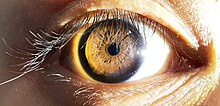Miosis,ormyosis(fromAncient Greekμύειν(múein)'to close the eyes'), is excessiveconstriction of the pupil.[1][2][3][4]The opposite condition,mydriasis,is thedilation of the pupil.Anisocoriais the condition of onepupilbeing more dilated than the other.
| Miosis | |
|---|---|
| Other names | Myosis, pinpoint pupil |
 | |
| Miosis from bright light pointed directly at the eye. Pupil measured 2.3 mm in diameter | |
| Pronunciation | |
| Specialty | Ophthalmology |
| Symptoms | Constricted pupils |
Causes
editAge
edit- Senile miosis (a reduction in the size of a person's pupil in old age)
Diseases
edit- Ehlers Danlos Syndrome
- Horner's syndrome
- Hemorrhageintopons(intracranial hemorrhage)
- Hereditary disorders
- Cluster headacheswithptosis
- Iridocyclitis
- Fatal familial insomnia
- Aphakia
Drugs
edit- Opioidssuch asfentanyl,morphine,heroinandmethadone(the notable exception beingpethidine)
- Products containingnicotinesuch as cigarettes,chewing tobaccoor gum
- Imidazolinessuch asclonidine,naphazoline,oxymetazolineandtetrahydrozoline
- Antipsychotics,includingrisperidone,haloperidol,chlorpromazine,olanzapine,quetiapine[5]
- Cholinergicagents such asacetylcholine
- Acetylcholinesterase inhibitors
- Serotonin antagonists,such asondansetron(an anti-emetic) known by its brand name Zofran/ Emiston in BD
- Some cancerchemotherapydrugs, includingcamptothecinderivatives
- Mirtazapine,anoradrenergic and specific serotonergic antidepressant(NaSSA)
- SomeMAO inhibitors
- Pilocarpineeye drops and all otherparasympathomimetics
- In some rare cases, when exposed tomustard gas
- Organophosphates
Physiology of the photomotor reflex
editLight entering the eye strikes three differentphotoreceptorsin theretina:the familiarrodsandconesused in image forming and the more newly discoveredphotosensitive ganglion cells.The ganglion cells give information about ambient light levels, and react sluggishly compared to the rods and cones. Signals from photosensitive ganglion cells have multiple functions including acute suppression of the hormonemelatonin,entrainmentof the body'scircadian rhythmsand regulation of the size of the pupil.
The retinal photoceptors convert light stimuli into electric impulses. Nerves involved in the resizing of the pupil connect to thepretectal nucleusof the highmidbrain,bypassing thelateral geniculate nucleusand the primaryvisual cortex.From the pretectal nucleus neurons send axons to neurons of theEdinger-Westphal nucleuswhosevisceromotoraxons run along both the left and rightoculomotor nerves.Visceromotor nerve axons (which constitute a portion ofcranial nerveIII, along with the somatomotor portion derived from the Edinger-Westphal nucleus) synapse onciliary ganglionneurons, whose parasympathetic axons innervate theiris sphincter muscle,producingmiosis.
See also
editReferences
edit- ^Farlex medical dictionaryciting:
- Miller-Keane Encyclopedia & Dictionary of Medicine, Nursing, and Allied Health,7th ed.
- Saunders Comprehensive Veterinary Dictionary, 3rd ed.
- ^Seidel HM, Ball JW, Dains JE, Benedict GW (2006-03-29).Mosby's Guide to Physical Examination.Mosby.ISBN978-0-323-03573-6.
- ^Farlex medical dictionaryciting: Millodot: Dictionary of Optometry and Visual Science, 7th ed.
- ^Farlex medical dictionaryciting: Mosby's Medical Dictionary, 8th ed.
- ^Hou RH, Scaife J, Freeman C, Langley RW, Szabadi E, Bradshaw CM (June 2006)."Relationship between sedation and pupillary function: comparison of diazepam and diphenhydramine".British Journal of Clinical Pharmacology.61(6): 752–60.doi:10.1111/j.1365-2125.2006.02632.x.PMC1885114.PMID16722841.